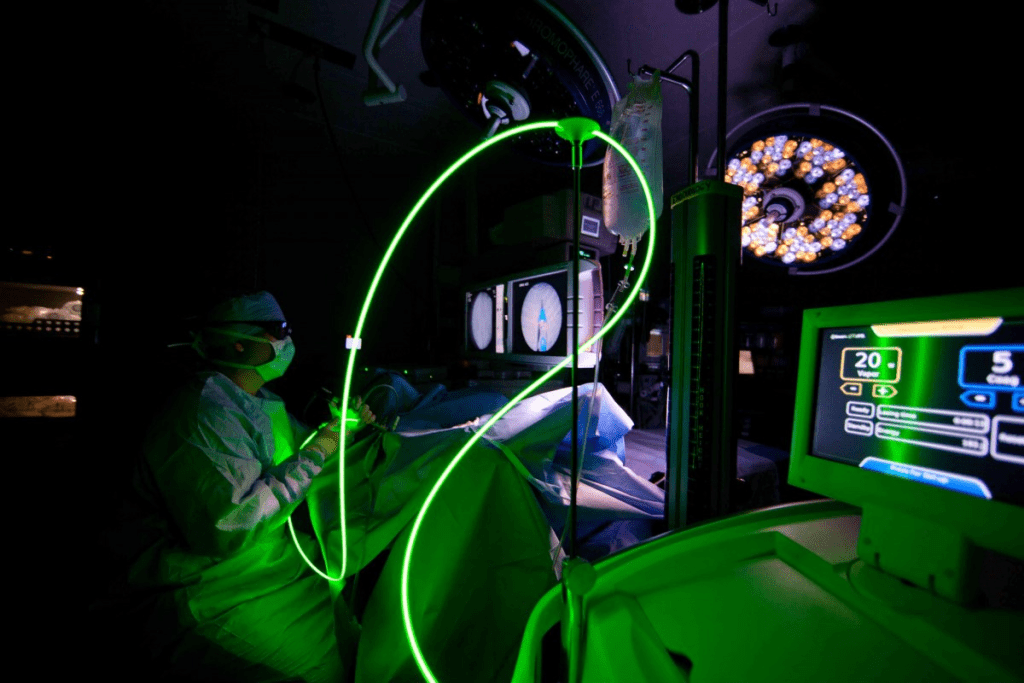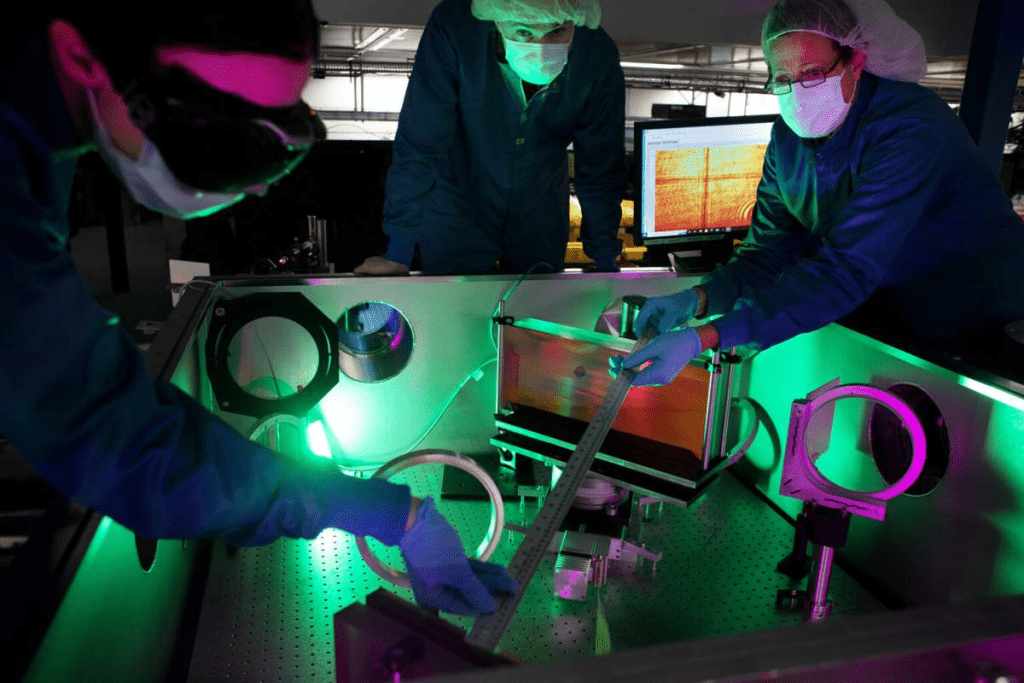Last Updated on October 31, 2025 by
What is the success rate of Green Light laser surgery? Get clear facts on its outcomes and safety.
GreenLight laser surgery, also known as photoselective vaporization of the prostate (PVP), is a minimally invasive treatment for Benign Prostatic Hyperplasia (BPH). It has become a popular choice for many.

This new procedure is known for its high success rate. It greatly improves urinary flow and lessens BPH symptoms. Studies show it works well for nearly 88% of patients at about 5 years after treatment.
Men with BPH can find relief with GreenLight laser surgery. This method has changed how we treat Benign Prostatic Hyperplasia. It offers symptom relief with less invasion.
GLPVP is a laser technique for BPH treatment. It uses a GreenLight laser to vaporize extra prostate tissue. This improves urine flow and lessens symptoms.
The GLPVP method is precise. It targets the prostate tissue that blocks urine flow. This approach causes less damage and leads to quicker healing than old surgical methods.

GreenLight laser surgery uses a powerful laser through a fiber optic cable. It targets and vaporizes prostate tissue. This widens the urethral channel and improves urine flow.
The surgery is done under local or general anesthesia. It’s safe and effective. The GreenLight laser technology ensures precise tissue removal. This reduces complications and speeds up healing.
GreenLight laser surgery offers many benefits:
GreenLight laser surgery’s success rate is key for both patients and doctors. Success is seen in better urine flow, fewer symptoms, and happy patients.
Success in prostate surgery, like the GreenLight laser, has many parts. It includes better urine flow and fewer symptoms. It also looks at how happy patients are and if their life gets better. Studies show that a big drop in the International Prostate Symptom Score (IPSS) means success.
The IPSS measures BPH symptoms. A lower score means fewer symptoms and better urine flow. Doctors use IPSS changes to see if surgery worked.
Studies show GreenLight laser surgery works for 82.1%, 80.8%, and 76.1% of patients at 1, 3, and 5 years. This means most patients see big improvements in symptoms and life quality.

Patients are very happy with the results. They say their urine flow is better, and they feel less pain. The surgery’s precision and minimally invasive nature help with these results.
Seeing symptoms get better is key to judging GreenLight laser surgery’s success. Studies show big drops in symptom scores after surgery. For example, a big drop in IPSS means better urine flow and fewer symptoms.
These stats show GreenLight laser surgery is good at managing BPH symptoms and improving patient outcomes.
The GreenLight laser technology has seen big changes over time. These changes have made it better at treating Benign Prostatic Hyperplasia (BPH). It’s important for patients and doctors to know about these changes.
GreenLight laser systems have gotten better with each new generation. The latest 180-Watt model is a big step up. It lasts longer and needs fewer follow-up surgeries than older models.
“The GreenLight laser technology has made huge strides,” says a top urologist. “It now offers a safer and more effective way to treat BPH.”
The 180-Watt GreenLight laser model works better and lasts longer for BPH treatment. Research shows it leads to fewer surgeries and better symptom relief for patients.
Recent studies say the 180-Watt model is a new benchmark for GreenLight laser prostate surgery.
Older GreenLight laser models were groundbreaking but had some limitations. They had higher surgery rates and less symptom relief than the 180-Watt model.
Knowing these limitations helps us see how far the technology has come.
Looking at the different GreenLight laser generations shows how much BPH treatment has improved. As technology keeps getting better, patients can look forward to even better results.
GreenLight laser prostate surgery is a key option for treating BPH. It offers long-lasting relief and improves quality of life. Studies show it works well for many patients.
GreenLight laser surgery helps with BPH symptoms for a long time. It removes tissue that blocks urine flow. Studies show these benefits last for years after surgery.
A study in the Journal of Urology found big improvements in symptoms and life quality. These results last because the surgery removes the blockage.
“The GreenLight laser system has revolutionized the treatment of BPH, making it safer and more effective than old methods.” “ A Urologist
Reoperation rates after GreenLight laser surgery. The size of the prostate, age, and health issues play a role. Mostly, the rates are low, showing the surgery’s lasting benefits.
Many things can affect how long the surgery’s benefits last. Choosing the right patient and using the best technique are key. Doing these well leads to better, longer-lasting results.
Good care after surgery is also important. Patients should live healthily and keep up with check-ups. Following the doctor’s orders helps keep the surgery’s benefits going.
What Is The Success Rate Of Green Light Laser Surgery?
Green light laser surgery is a modern medical procedure primarily used to treat benign prostatic hyperplasia (BPH), a non-cancerous enlargement of the prostate gland that commonly affects older men. This minimally invasive technique utilizes a specialized laser to remove excess prostate tissue that obstructs urine flow, offering a safe and effective alternative to traditional surgeries like transurethral resection of the prostate (TURP). Understanding the success rate of green light laser surgery helps patients and healthcare providers make informed decisions about treatment options. This article explores the procedure, factors influencing its effectiveness, outcomes, and what patients can expect.
Green light laser surgery, also known as photoselective vaporization of the prostate (PVP), involves using a high-powered laser that emits green light to vaporize enlarged prostate tissue. The laser is delivered through a thin fiber inserted into the urethra, directly targeting obstructive tissue while minimizing damage to surrounding structures. This precision reduces bleeding, shortens hospital stays, and accelerates recovery.
Unlike conventional surgical procedures that require incisions, green light laser surgery is typically done on an outpatient basis or with a short hospital stay. Patients often experience rapid relief from urinary symptoms such as difficulty urinating, increased frequency, and urgency.
Studies consistently report high success rates for green light laser surgery in relieving symptoms of BPH and improving urinary flow. Clinical success is generally measured through parameters like:
Research indicates that up to 85-95% of patients experience significant symptom improvement within weeks after surgery. Furthermore, long-term follow-up studies show durable results with continued relief reported 5 to 10 years post-procedure.
Several factors influence the success rate of green light laser surgery:
Green light laser surgery’s success is reinforced by its minimally invasive nature and favorable safety profile:
When compared to TURP, the longstanding gold standard for BPH, green light laser surgery shows comparable efficacy with fewer side effects. While TURP achieves excellent symptom relief, it carries higher risks of bleeding, electrolyte imbalances, and longer catheterization time.
Other laser options, like holmium laser enucleation (HoLEP), also offer similar benefits, especially for very large prostates. Choosing the best surgical option depends on individual patient factors and surgeon expertise.
Patient-reported outcomes reflect high satisfaction rates after green light laser surgery. Most men report:
Despite its excellent success rate, green light laser surgery carries some potential risks, including:
Proper patient selection and postoperative care minimize these risks.
Long-term data indicate that green light laser surgery provides durable symptom relief, with retreatment rates generally below 10% over 5 to 10 years. This makes it a reliable option for sustainable management of BPH.
GreenLight laser surgery is a top choice for treating BPH. It greatly improves urinary symptoms and boosts quality of life.
Before deciding, it’s key to look at the procedure’s success rates and long-term effects. Research proves GreenLight laser surgery is safe and works well for many patients.
Choosing GreenLight laser surgery depends on your personal health needs. Knowing how well it works and its outcomes helps you decide on the best BPH treatment for you.
GreenLight laser surgery is a treatment for BPH. It uses a laser to remove extra prostate tissue. This helps improve urine flow and reduce BPH symptoms.
The surgery uses a GreenLight laser. It targets and removes prostate tissue. This helps improve urine flow and reduce BPH symptoms.
Studies show it works well for most patients. Success rates are 82.1%, 80.8%, and 76.1% at 1, 3, and 5 years. This means most patients see big improvements in their symptoms and life quality.
It offers long-term relief from BPH symptoms. Patients see big improvements in urine flow and life quality. But some may need another surgery later.
The 180-Watt model works better and lasts longer. It has lower reoperation rates and better symptom relief than older models.
Many things can affect how long the surgery lasts. These include the patient’s health and other conditions they might have.
Yes, it’s a great option for many BPH patients. It’s safe and effective for those with BPH symptoms.
Subscribe to our e-newsletter to stay informed about the latest innovations in the world of health and exclusive offers!